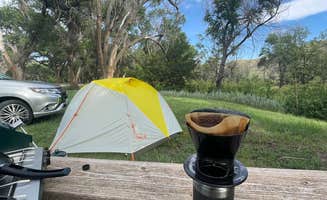Tent camping near Garden City, Kansas primarily centers around Historic Lake Scott State Park, located approximately 50 miles north in Scott County. The park sits at an elevation of 2,966 feet in a natural basin created by spring-fed Ladder Creek, providing cooler temperatures than the surrounding plains. Summer temperatures average 90°F during peak camping season while spring and fall offer milder conditions with lows in the 40s-50s.
What to do
Water recreation opportunities: Timber Canyon Campground offers direct lake access for anglers targeting channel catfish, bluegill, and bass. According to one visitor, "Cozy and friendly Beach house workers and Great Fishing and Camping grounds." The 100-acre Lake Scott remains one of western Kansas's best fishing destinations.
Historic site exploration: Horsethief Campground places campers near El Cuartelejo, the northernmost Native American pueblo ruins and a registered National Historic Landmark. Interpretive trails explain the site's significance and the area's unique geological formations.
Wildlife viewing: Morning hikes around the lake offer opportunities to spot deer, wild turkeys, and various bird species. The park's sheltered basin creates a microclimate supporting diverse wildlife unusual for western Kansas, making dawn and dusk ideal for wildlife photography.
What campers like
Natural wind protection: The basin geography at Lake Scott creates natural wind breaks important in this notoriously windy region. One camper at Timber Canyon Campground noted, "These spaces are blocked from the wind and feel more private than the Lakeview campground, but you are a bit further from bathrooms/dumpsters."
Secluded camping spots: Primitive tent sites at Lake Scott offer more seclusion than the main camping areas. Many tent campers appreciate finding "little coves" to themselves, particularly in less-developed areas of the park where natural features create semi-private camping nooks.
Storm shelters: Some sites feature covered structures that provide weather protection during Kansas's unpredictable storms. As one camper shared about her experience at Timber Canyon, "I stayed for one night on the site with the covered shelter, and it worked out wonderfully because we had a huge lightning storm in the middle of the night."
What you should know
Site accessibility considerations: While most campgrounds offer drive-in access, Boat Ramp Campsites require campers to consider their proximity to amenities. Sites with the best views often involve longer walks to facilities, with some requiring quarter-mile walks to restrooms.
Primitive site limitations: Bull Canyon and other primitive areas have significantly fewer amenities than main camping areas. These sites lack drinking water and electrical hookups, requiring campers to be self-sufficient with water supplies for overnight stays.
Seasonal availability: During peak summer weekends, particularly holiday periods, the most desirable lakeside sites fill quickly. Reservations are recommended from Memorial Day through Labor Day, as weekend occupancy often reaches capacity by Friday afternoon.
Tips for camping with families
Campsite selection strategy: Choose sites based on your priorities for bathroom access versus privacy. A visitor to Timber Canyon noted that their site "would be difficult for family with young children because it is far away from the pit toilet," highlighting the importance of considering facility proximity when camping with kids.
Swimming considerations: The designated swimming area near Flatland Campground offers shallow entry points suitable for younger children, though the lake lacks lifeguards. Parents should note that water clarity varies throughout the season, with early summer typically providing the clearest conditions.
Educational opportunities: The park's history provides natural learning opportunities through interpretive displays about Native American history and pioneer settlements. Families can complete the Junior Ranger program available at the park office to enhance children's understanding of the area's cultural and natural history.
Tips from RVers
Utility hookup distribution: Electric and water hookups are concentrated in specific areas of Bullcanyon Campground, leaving primitive areas primarily for tent campers. RVers note that most visitors with larger vehicles tend to cluster in developed sections with full hookups.
Lake access considerations: RV sites with the best lake views typically fill first but may require longer vehicles to navigate tighter turns. Sites farther from the lake offer easier access for larger rigs, with more straightforward approaches and level parking pads.
Dump station logistics: The park provides a centralized dump station rather than individual sewer hookups at most sites. RVers should plan to use this facility when entering or leaving the park, as access can become congested during peak checkout times on Sunday mornings.


